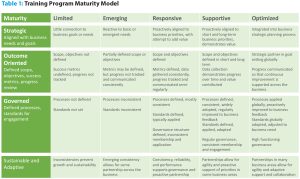Training Frameworks – By Danielle Duran
Training isn’t one-size-fits-all: Adjustments must be made
If lucky, a company’s training department will contain professionals with deep knowledge of effective learning strategies, practices, theory and application.
It is also a double edged sword for any company that finds itself short on time, and heavy on critical priorities. There can be a fear that the training professionals may make demands that feel overbuilt or complicated, leading to missed opportunities for collaboration or partnership.
Both sides of the teams suffer in these cases, usually with less efficiency and more rework.
Training programs, as much as any other programs, must be fit-for-purpose. A given company may require overall training programs to be on the more simplified side of the spectrum, or a given company may have varying levels of complexity throughout and so different programs must operate at different levels of maturity. There is never a one-size-fits-all, and often adjustments must be made continually.
The Maturity Model
To provide a shared language and understanding of training program maturity, the following maturity model begins with limited maturity, and moves through emerging, responsive, supportive and finally an optimized maturity level. The four key components evaluated are the extent to which the program is strategic, outcome-oriented, governed and sustainable & adaptive. (See Table 1.)
This high-level framework helps you identify where you are now, so you can decide if you’re in an appropriate place. It provides a few guideposts to think about how to move up or down in maturity based on the business need, whether for individual programs or for the program overall.
Each line could be broken down much further with many rabbit holes of detail, of course, but this can also serve as a touchstone for conversations with leadership and so its simplicity serves to support cross-functional conversation.
Trainers want customer groups to feel confident that we will prioritize meeting the business need, that we can adjust to be fit-for-purpose, as appropriate, and that we are ready to talk about increasing optimization in partnership with them as they become increasingly ready. We must keep our language and approach simple so that we can mutually prioritize and partner.
Strategic
The first component to evaluate for maturity is one of the most critical for ensuring value is provided to the business. Ensuring the right level of strategy can also serve to provide a strong foundation for partnership and to build trust. You will be able to evaluate your current state, and you will see what it will take to grow in maturity.
It is in this component that it is most critical to engage with other areas of the business while you evaluate where you are. Then collaborate to decide how, when, how much and how quickly to grow in maturity. As this component is all about partnership, it requires partnership in all related actions related.
In the earliest stages, training programs may be primarily tactical and focused on accomplishing tasks, especially as an “order taker” to support the business. They may be led by junior personnel, who may take direction from leadership under great time pressure.
It is also possible that its leadership or the leadership from which it gets direction may not have ever seen a training program function at a higher level of leadership.
They may have only experienced training in this tactical sense, or perhaps as managers of suppliers or supplier-driven products.
To grow from the limited level, one must find a way to hold time and space to ensure deeper understanding of business goals or needs. Find a quarter of an hour or half an hour a few times in a month to speak to various colleagues and geta broader perspective and think about what it would look like to react to or proactively plan for meeting needs and demonstrate increasing alignment.
Over time, deeper understanding can enable proactive planning or taking actions that demonstrate value (think about Kirkpatrick levels 3 and 4 here).
Growth requires further understanding of current and future priorities, as well as industry trends to anticipate coming priorities. Ongoing development of business acumen allows one to understand how the business does its goal setting and strategic planning, and identify opportunities to contribute.
In the beginning, that may be supporting leadership from outside the process. At an optimized level, the learning group would be fully integrated at the leadership level to support and contribute strategically in full partnership.
Outcome-Oriented
The extent to which a program is outcome-oriented will support its ability to be strategic. The more outcome-oriented it is, the more the program will be able to demonstrate its value.
In the early and limited stages of maturity, a program is tactical on the strategic side, but also tactical in its orientation. It may accomplish tasks and fulfill orders but may not be doing so within a clearly defined scope. The activities being accomplished may not add up to a greater clear objective.
The number of activities may be quantifiable, but without a broader measurement approach (which metrics will be used and how, how they will be tracked or communicated), the story behind the numbers may stay more opaque and less influentially clear.
As growth in maturity is reached along these lines, with clear metrics and well-communicated and commonly understood progress tracked, business leadership will be more keen to partner and strategic maturity will come hand-in-hand. Partnership will grow organically as quantitative demonstration of value will attract high-performing ally teams and individuals.
As you consider where you are within this component of maturity, consider how you feel about your work. Does it feel more like being “busy,” or does it feel more like being “accomplished and productive”?
Working with clearly defined goals and knowing where you are on the way to achieving them can reduce feelings of anxiety as you reduce the ambiguity. Having the power to quantitatively answer the question of impact provides additional credibility and will facilitate partnership.
Governed
All components are of course closely tied and are also interdependent. This makes it difficult to move too high up in any given component while leaving others behind. Training program governance refers to the extent to which processes within the program are defined, including structures for cross-functional engagement and partnerships.
On the lower ends of maturity, the extent to which processes are defined will likely mirror the level outcome orientation of the program. Defined processes will enable a program to increase how significantly it can make progress toward its defined outcomes. Increasingly consistent performance and increasingly consistent adherence to standards will build trust with cross-functional partners and leaders as the program demonstrates its effectiveness.
As growth in maturity increases across the spectrum, there are increasingly consistent and defined opportunities for engagement and partnership, which also enables increased space to be strategic. Increased growth includes consideration for an increased scope across the organization. It may not necessarily mean that a program must govern globally, but it must take the global enterprise into account.
There may be multiple (not centralized) programs. How can effective and strategic collaboration be supported through defined processes and governance? Thinking back to the importance of considering the double-edged sword, this must also befit-for-purpose and meet business needs.
There may be times or projects that require more flexibility in process definition or agility in their adjustment. There may be times that the governance can be defined but membership will be in flux. There may be times that the push and pull between the learning team and business leaders will also fluctuate. The more strategic and outcome-oriented the program is, the more capability will exist to flow up and down the maturity in areas of governance.
Sustainable & Adaptive
The ability to flow up and down levels of maturity, while generally aiming to lean toward progress in the upward direction, will enable the most effective contributions from a learning team and can best optimize business performance. There will be times that inconsistencies and ambiguities are completely out of the control of the learning team or other business leaders, but working toward increased consistency and reliability will support effective partnerships that benefit everyone.
At the more optimal end of maturity, the support and collaboration afforded by partnerships will also enable higher-level strategy. Having more clearly defined outcomes and processes will enable the partnership conversations and meaningful and aligned partnership to flourish.
Conclusion
Throughout the model, clarity and collaboration are the keys to success. It is powerful to know where you stand in your current state and motivating to think about where you want to go next.
Be sure to engage with your business partners as you determine the best prioritized steps forward, or to adjust down to meet changing business needs. Ensure you support them to continue moving ahead as priorities allow.
 Danielle Duran is director, GxP compliance and training, Aimmune Therapeutics, a Nestle Health Science company.
Danielle Duran is director, GxP compliance and training, Aimmune Therapeutics, a Nestle Health Science company.










